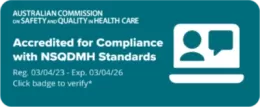Quick Facts
Dialectical behaviour therapy (DBT) is a modified version of cognitive-behavioural therapy (CBT) designed to treat borderline personality disorder (BPD). It can also be used to treat other conditions, like suicidal behaviour, self-harm, substance use, post-traumatic stress disorder (PTSD), depression and eating disorders.
-
How DBT works
The term ‘dialectical’ means ‘working with opposites’. DBT uses seemingly opposing strategies of ‘acceptance’ and ‘change’. The therapist accepts you just as you are, but acknowledges the need for change in order for you to recover, move forward and reach your personal goals.
During a course of DBT, the therapist works with you to help you move away from harmful coping behaviours and towards a life that you find personally meaningful and fulfilling.
DBT involves developing two sets of acceptance-oriented skills and two sets of change-oriented skills.
-
Acceptance-oriented skills
Mindfulness
Learning how to focus your awareness on the present moment, and to acknowledge and accept your thoughts, feelings, behaviours and bodily sensations as they occur, without the need to control or manipulate them.
Related: Mindfulness
Distress tolerance
Learning how to manage and cope during a crisis, and to tolerate distress when it is difficult or impossible to change a situation. Learning to accept any given situation just as it is, rather than how you think it should be, or want it to be. Learning new skills like distraction and self-soothing, for both coping with and improving distressing moments.
-
Change-oriented skills
Emotional regulation
Learning how to effectively manage your emotional experience, and not allow your emotions to manage you.
Interpersonal effectiveness
Learning assertiveness strategies to appropriately ask for what you want or need. Learning how to say no, and how to manage interpersonal conflict in a way that maintains respect for yourself and others.
A typical course of DBT
DBT is typically run as a 24-week program, often taken twice to create a one-year program. In its standard form, there are three ways you receive DBT during the program. There are also shorter versions of DBT such as 12 week courses depending on the setting, and some versions do not include telephone coaching. DBT has been adapted for different needs.
DBT skills training group
A group facilitator teaches specific skills in a classroom setting, and sets tasks for the group members to practise between sessions. The skills training group typically meets once weekly, usually for around 2½ hours, across the 24-week program.
Individual therapy
Running at the same time as the group, individual therapy typically occurs weekly to enhance your motivation and commitment to the program. It’s also an opportunity to discuss and apply specific DBT skills to your current everyday life.
Between-sessions telephone coaching
On-the-spot telephone coaching from your therapist can be available at times during the week when you’re struggling. Your therapist guides you and encourages you to apply your new DBT skills to address and manage your issues.
-
How to get DBT treatment
In most Australian states, DBT programs can be accessed through both the public and private mental health system.
Public services
Some hospitals may run public DBT programs. Talk to your case manager, mental health professional or GP about referral options.
Private services
Private DBT programs require payment. Prices will vary depending on the specific service you choose. If you have private health insurance, check that it covers psychiatric admissions.
If you don’t have private health insurance but you’re eligible for the National Disability Insurance Scheme (NDIS), you may be able to allocate funds to access a DBT program within the private system.
To join a private DBT program, a psychiatrist from the specific hospital or clinic can provide a referral for you.
Finding a service near you
To find services providing BPD treatment in Australia or New Zealand, visit Project Air Strategy’s Service Directory.
For state-based mental health assistance:
- Victorian Mental Health Service Directory and Spectrum
- NSW Mental Health Line on 1800 011 511 (available 24 hours)
- ACT Mental Health Triage Service 1800 629 354
- QLD Health 13 43 25 84
- SA Health Mental Health Triage Service on 13 14 65 (available 24 hours)
- WA Mental Health Emergency Response Line 1300 555 788 (metro) or 08 9224 8888 (State Wide)
- Tasmanian Mental Health Service Helpline 1800 332 388
- NT Crisis Assessment Telephone Triage and Liaison Service 1800 682 288.
-
References
- Gottman, J. M., & Levenson, R. W. (1992). Marital processes predictive of later dissolution: Behavior, physiology, and health. Journal of Personality and Social Psychology, 63, 221–233.
- Wegner, D. M., & Erber, R. (1992). The hyperaccessibility of suppressed thoughts. Journal of Personality and Social Psychology, 63, 903–912.
- Goldfried, M. R., & Davison, G. C. (1976). Clinical behavior therapy. New York: Holt, Rinehart & Winston.
- Roemer, L., & Borkovec, T. D. (1994). Effects of suppressing thoughts about emotional material. Journal of Abnormal Psychology, 103, 467–474.
- Wegner, D. M., Schneider, D. J., Carter, S. R., & White, T. L. (1987). Paradoxical effects of thought suppression. Journal of Personality and Social Psychology, 53, 5–13.
- De Mello, A. (1984). The song of the bird. New York: Image Books.
- Nagasako, E. M., Oaklander, A. L., & Dworkin, R.H. (2003). Congenital insensitivity to pain: An update. Pain, 101(3), 213–219.
- Kabat-Zinn, J. (1990). Full catastrophe living: Using the wisdom of your body and mind to face stress, pain, and illness. New York: Delacorte Press.
- Gross, J. J., & Levenson, R. W. (1997). Hiding feelings: The acute effects of inhibiting negative and positive emotion. Journal of Abnormal Psychology, 106, 95–103.
- Gross, J. J., & John, O. P. (2003). Individual differences in two emotion regulation processes: Implications for affect, relationships, and well-being. Journal of Personality and Social Psychology, 85, 348–362.
This SANE factsheet was reviewed by industry professionals.
This SANE resource was created with support from The Vizard Foundation.









